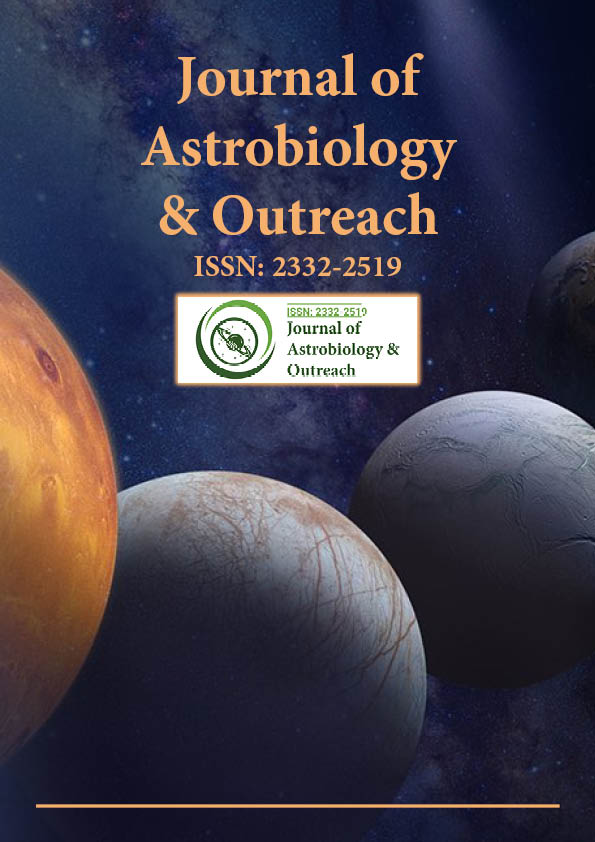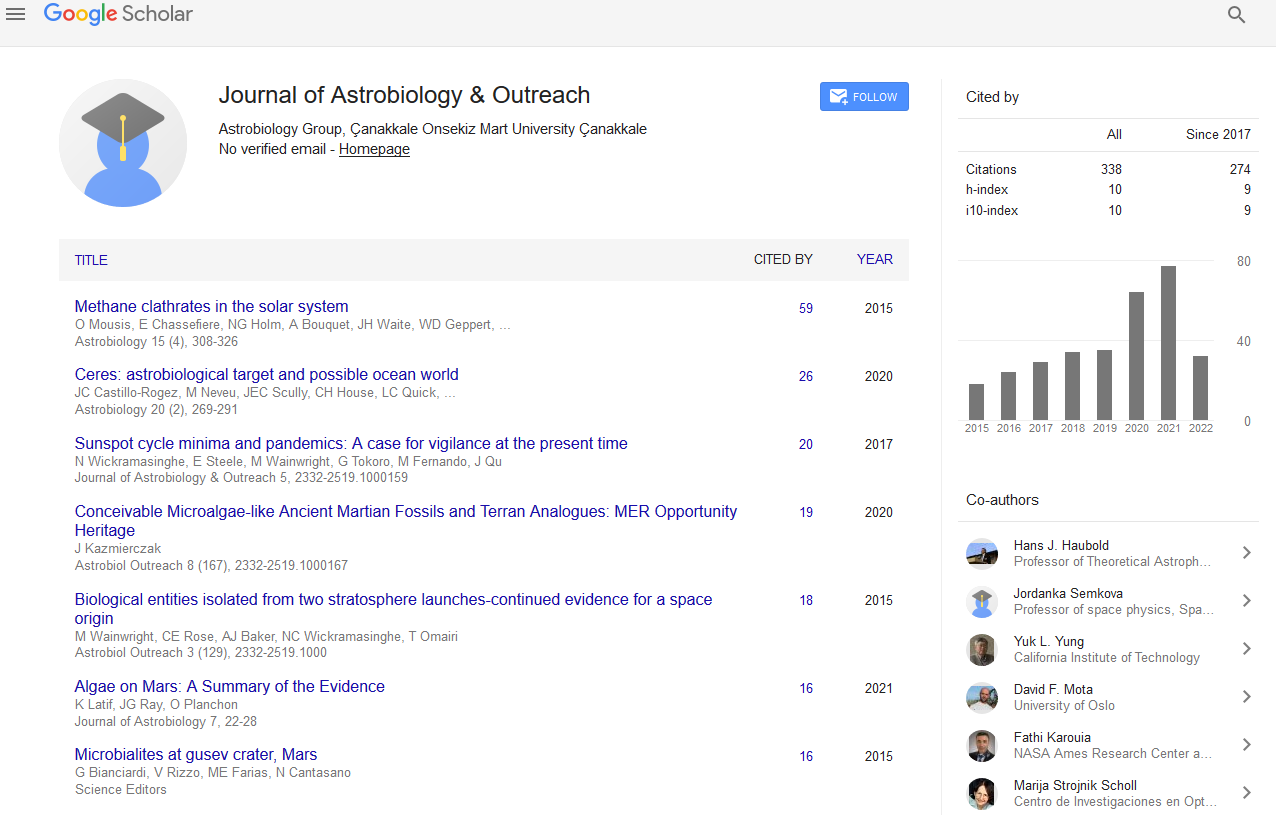Indexed In
- Open J Gate
- Academic Keys
- JournalTOCs
- RefSeek
- Hamdard University
- EBSCO A-Z
- OCLC- WorldCat
- Google Scholar
Useful Links
Share This Page
Journal Flyer

Open Access Journals
- Agri and Aquaculture
- Biochemistry
- Bioinformatics & Systems Biology
- Business & Management
- Chemistry
- Clinical Sciences
- Engineering
- Food & Nutrition
- General Science
- Genetics & Molecular Biology
- Immunology & Microbiology
- Medical Sciences
- Neuroscience & Psychology
- Nursing & Health Care
- Pharmaceutical Sciences
Opinion Article - (2023) Volume 11, Issue 3
Exploring the Significance of Organism-Substrate Interactions in Astrobiology: Unraveling Potential, Models, and Methodologies
Genova Devid*Received: 01-May-2023, Manuscript No. JAO-23-21761; Editor assigned: 03-May-2023, Pre QC No. JAO-23-21761 (PQ); Reviewed: 17-May-2023, QC No. JAO-23-21761; Revised: 24-May-2023, Manuscript No. JAO-23-21761 (R); Published: 31-May-2023, DOI: 10.35248/2332-2519.23.11.298
Description
Organism-substrate interactions play a crucial role in astrobiology, offering insights into the potential for life beyond Earth. Understanding how organisms interact with their environment, particularly with substrates (surfaces or materials), is essential for studying habitability, searching for bio signatures, and developing models and methods in astrobiology research. This commentary delves into the significance of organismsubstrate interactions in astrobiology, highlighting their potential implications, the models used to study them, and the methods employed to investigate these complex interactions.
Unveiling the potential
Organism-substrate interactions hold immense potential in astrobiology research. By studying how organisms interact with substrates, scientists can infer important information about the habitability of environments and the potential for life to arise and persist. For example, the investigation of microbial life in extreme environments on Earth, such as hydrothermal vents or acidic lakes, provides insights into the adaptability of organisms to extreme conditions. This knowledge helps researchers identify potential habitats and conditions where life might exist beyond our planet.
Models for studying interactions
To study organism-substrate interactions, scientists employ various models that simulate different environmental conditions and biological systems. Laboratory experiments with microorganisms grown on different substrates allow researchers to understand how organisms interact with and modify their environment. These models enable the exploration of biological processes and the assessment of the potential for life to thrive in specific environments, such as the icy moons of Jupiter or Mars' subsurface.
Additionally, computer simulations and modeling techniques provide valuable insights into organism-substrate interactions on a larger scale. These simulations help scientists understand the dynamics of complex ecosystems, the evolution of organisms in response to environmental changes, and the potential for habitability in diverse environments.
Investigative methods
A wide range of methods are employed to investigate organismsubstrate interactions in astrobiology research. Microscopic imaging techniques, such as Scanning Electron Microscopy (SEM) and Atomic Force Microscopy (AFM), allow scientists to observe the interactions between microorganisms and substrates at high resolution. These methods help in characterizing microbial communities, their attachment mechanisms, and the formation of biofilms.
Chemical analysis techniques, including spectroscopy and mass spectrometry, provide valuable information about the composition and potential bio signatures associated with organisms and substrates. By analyzing the chemical signatures and biomolecules present in samples, scientists can assess the potential for life and its interactions with the environment.
In situ investigations, such as lander missions or rovers, provide direct observations and measurements of organism-substrate interactions in extraterrestrial environments. These missions allow for the collection of samples, the analysis of surface features, and the detection of potential signs of life, contributing to our understanding of habitability and the potential for extraterrestrial life.
Conclusion
Organism-substrate interactions play a vital role in astrobiology research, offering valuable insights into habitability, the potential for life beyond earth, and the development of models and methods in the field. By studying how organisms interact with their environment and substrates, scientists can explore the adaptability of life in extreme conditions, assess habitability factors, and search for bio signatures. Through the use of various models and investigative methods, researchers continue to unravel the intricacies of organism-substrate interactions, driving our understanding of astrobiology and the potential for life in the universe.
Citation: Devid G (2023) Exploring the Significance of Organism-Substrate Interactions in Astrobiology: Unraveling Potential, Models, and Methodologies. J Astrobiol Outreach. 11.298.
Copyright: © 2023 Devid G. This is an open-access article distributed under the terms of the Creative Commons Attribution License, which permits unrestricted use, distribution, and reproduction in any medium, provided the original author and source are credited.

